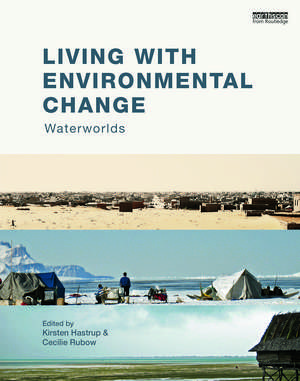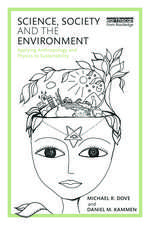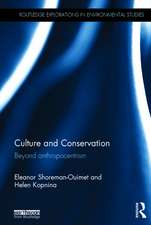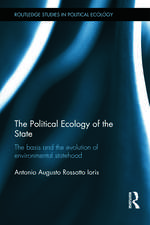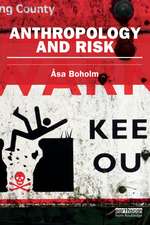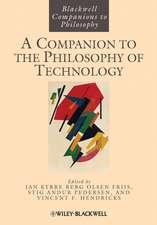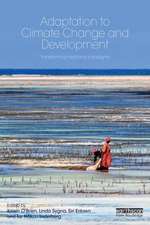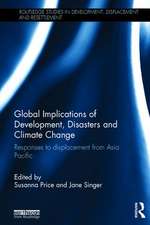Living with Environmental Change: Waterworlds
Editat de Kirsten Hastrup, Cecilie Rubowen Limba Engleză Hardback – 5 mar 2014
Preț: 260.27 lei
Preț vechi: 298.78 lei
-13% Nou
Puncte Express: 390
Preț estimativ în valută:
49.81€ • 54.08$ • 41.84£
49.81€ • 54.08$ • 41.84£
Carte tipărită la comandă
Livrare economică 22 aprilie-06 mai
Preluare comenzi: 021 569.72.76
Specificații
ISBN-13: 9780415746670
ISBN-10: 0415746671
Pagini: 320
Ilustrații: 266 black & white illustrations, 266 black & white halftones
Dimensiuni: 219 x 276 x 23 mm
Greutate: 1.4 kg
Ediția:New.
Editura: Taylor & Francis
Colecția Routledge
Locul publicării:Oxford, United Kingdom
ISBN-10: 0415746671
Pagini: 320
Ilustrații: 266 black & white illustrations, 266 black & white halftones
Dimensiuni: 219 x 276 x 23 mm
Greutate: 1.4 kg
Ediția:New.
Editura: Taylor & Francis
Colecția Routledge
Locul publicării:Oxford, United Kingdom
Public țintă
Academic, General, Postgraduate, Professional, Professional Practice & Development, and UndergraduateCuprins
Introduction Portraits Part 1 Water 1. Introduction Kirsten Hastrup 2. Narwhals and Navigators on the Arctic Sea Kirsten Hastrup 3. Ephemeral Tsunamis, Emotional Waves, and Enduring Islands Maria Louise B. Robertson 4. Sea Water to the Mountain Top: The Hydrological Cycle in Chivay, Peru Astrid B. Stensrud 5. Bursting Bodies of Water Mattias B. Rasmussen 6. When it Rains and the River Grows Astrid O. Andersen 7. The Elusive Pleasure of Rain in the Sahel Jonas Ø. Nielsen 8. Dams: Management versus Luck Mette F. Olwig 9. Water as Power and Destroyer Frank Sejersen 10. New Opportunities turning into Disaster Anette Reenberg 11. Coastal Gardens and their Magic Frida Hastrup 11. The Sprawled Way of Detergents Cecilie Rubow 12. Droughts: Complex Social Phenomena Christian Vium 13. Water Quantity vs. Water Quality Laura V. Rasmussen 14. Fixed and Fluid Waters: Mirroring the Arctic and the Pacific Kirsten Hastrup and Maria Louise B. Robertson Part 2. Technology 15. Introduction Cecilie Rubow 16. Sea Level and Coastal Protection Cecilie Rubow 17. Urbanizing Water in a Context of Scarcity Christian Vium 18. A Job-Machine Powered by Water Frank Sejersen 19. Life in the Shadow of a Water Tower Astrid O. Andersen 20. Waste and Water – Connected and Mixed Maria Louise B. Robertson 21. Inverted Watering Strategies in Senegal Anette Reenberg 22. Cobs as Technological Solutions Mette F. Olwig 23. The Imagined Water Pump Jonas Ø. Nielsen 24. Unpredictable Side Effects of New Technologies Laura V. Rasmussen 25. Scalable and Fluid Sprinklers Astrid B. Stensrud 26. Dry Technologies and Community Bureaucracies Mattias B. Rasmussen 27. A Life Jacket Story Frida Hastrup 28. Unpacking the Dog Sledge Kirsten Hastrup 29. Water Technologies. Mirroring Great Expectations in Greenland and Ghana Mette F. Olwig and Frank Sejersen Part 3. Landscape 30. Introduction Kirsten Hastrup 31. Hualca Hualca: Mountain Lord and Life Source Astrid B. Stensrud 32. Knowing Landscapes of Water in Kiribati Maria Louise B. Robertson 33. Borders at sea Frida Hastrup 34. Making Urban Landscapes – People, Water, Materials Astrid O. Andersen 35. Dreams, Water and the Remodelling of Place Frank Sejersen 36. Strategic Thinking: Changeable Usages of the Nigerien Landscape Anette Reenberg 37. Landscapes of Droughts and Floods on the Desert Margins Laura V. Rasmussen 38. A Landscape of Ice - Kirsten Hastrup 39. Walking Along Water Mattias B. Rasmussen 39. Old Water, Gardens and Prophetic Powers in the Sahel Jonas Ø. Nielsen 40. Can You See Climate Change in a Changing Environment? Cecilie Rubow 41. Mental Topographies Mette F. Olwig 42. Nomadic Landscapes and Ephemeral Resources - Christian Vium 43. Icons of Climate Change. Mirroring the Sahel and the Andes Astrid O. Andersen/Jonas Ø. Nielsen Part 4. Time 44. Introduction Cecilie Rubow 45. Glacial Time Kirsten Hastrup 46. Seasons, Timings, and the Rhythms of Life Mattias B. Rasmussen 47. Flexible Trajectories: Nomadic Pastoral Mobility Patterns Christian Vium 48. Still Life on the Shore Frida Hastrup 49. Appraising Change: A Question of Baseline Anette Reenberg 50. Litres per Second: Measuring the Water Flow Astrid B. Stensrud 51. New Scenarios and Unstable Temporalities Cecilie Rubow 52. Facing Reality - Managing/Imagining the Time Left on an Atoll Maria Louise B. Robertson 53. Anticipating Futures and the Rhythms of Water - Frank Sejersen 54. Slow versus Fast Changes in Sahelian Land Use Systems Laura V. Rasmussen 55. Three Calendars and the Test of Time in Northern Sahel Jonas Ø. Nielsen 56. "Packages" with Disparate Time Horizons Mette F. Olwig 57. Urban Talks of Climate and Weather Astrid O. Andersen 58. Times of Climate Change in Religion and Ethics. Mirroring the Andes and the Pacific Cecilie Rubow and Mattias B. Rasmussen
Recenzii
Is it possible to understand climate change through scientific theories, data and models? Hastrup and Rubow in this important book show why the answer is a decisive ‘no’. Drawing upon a rich and diverse array of sites around the world, Living with Environmental Change: Waterworlds offers dozens of compelling portraits of what climate change means to different people living in different places. This impressive collection of short essays shows why the anthropological study of climate change is at least as important as its scientific study. Rather than something to be feared, climate change is becoming part of the way in which humans and their cultures continually respond to the future and thereby re-shape it.
–Mike Hulme, King’s College London, UK
A unique contribution to the understanding of climate change as it appears to people all over the world. Using the framework of water, landscape, technology and climate it is a bold attempt to summarise a lot of human interest, experience and theory. It should be appreciated by anyone interested in the topic and not just by specialists.
–Jonathan Paul Marshall, University Technology Sydney, Australia
The Waterworlds team has produced a book that ‘shows rather than tells’ how communities experience climate change at a local level. By highlighting narratives from different parts of the world, they illuminate the complex pressures that emerge as shifts in climate initiate changes in social and material environments, as well as the creative adaptations that people are making in confronting these challenges.
–Veronica Strang, Durham University, UK
Like a splash of cold water on the face of someone who has grown drowsy, this book awakens the reader to the urgency of water issues in every corner of our world. Like a glass of cool water on a hot dry day, it slakes the reader’s thirst for a full understanding of the issues that will permit the construction of a sustainable future.
–Ben Orlove, Columbia University, USA
Of the many ways of considering climate change, this large format and lavishly illustrated book uses the lens of anthropology: what climate change means to different people living in a diversity of sites ranging from Greenland to Burkina Faso, Ghana, India, Mauritania and Peru to the Cook Islands and Kiribati.
–Spore Magazine
Supported by its colourful and personal presentation, both in text and appearance, this a great contribution to easily accessible knowledge and therefore makes it a highly valuable read for all audiences. It opens avenues for further enquiry and calls for further contributions of this type on local and regional life with environmental change.
–Nikolas Sellheim, University of Lapland, Finland
–Mike Hulme, King’s College London, UK
A unique contribution to the understanding of climate change as it appears to people all over the world. Using the framework of water, landscape, technology and climate it is a bold attempt to summarise a lot of human interest, experience and theory. It should be appreciated by anyone interested in the topic and not just by specialists.
–Jonathan Paul Marshall, University Technology Sydney, Australia
The Waterworlds team has produced a book that ‘shows rather than tells’ how communities experience climate change at a local level. By highlighting narratives from different parts of the world, they illuminate the complex pressures that emerge as shifts in climate initiate changes in social and material environments, as well as the creative adaptations that people are making in confronting these challenges.
–Veronica Strang, Durham University, UK
Like a splash of cold water on the face of someone who has grown drowsy, this book awakens the reader to the urgency of water issues in every corner of our world. Like a glass of cool water on a hot dry day, it slakes the reader’s thirst for a full understanding of the issues that will permit the construction of a sustainable future.
–Ben Orlove, Columbia University, USA
Of the many ways of considering climate change, this large format and lavishly illustrated book uses the lens of anthropology: what climate change means to different people living in a diversity of sites ranging from Greenland to Burkina Faso, Ghana, India, Mauritania and Peru to the Cook Islands and Kiribati.
–Spore Magazine
Supported by its colourful and personal presentation, both in text and appearance, this a great contribution to easily accessible knowledge and therefore makes it a highly valuable read for all audiences. It opens avenues for further enquiry and calls for further contributions of this type on local and regional life with environmental change.
–Nikolas Sellheim, University of Lapland, Finland
Notă biografică
Kirsten Hastrup is Professor at the Department of Anthropology, University of Copenhagen, Denmark. Cecilie Rubow is Associate Professor at the Department of Anthropology, University of Copenhagen, Denmark.
Descriere
Climate change is a lived experience of changes in the environment, often destroying conventional forms of subsistence and production, creating new patterns of movement and connection, and transforming people's imagined future. This book explores how people across the world think about environmental change and how they act upon the perception of past, present, and future opportunities.
